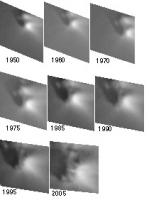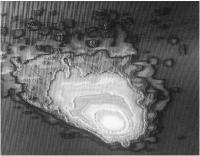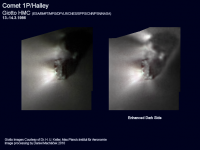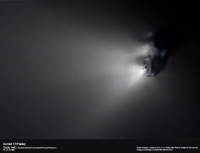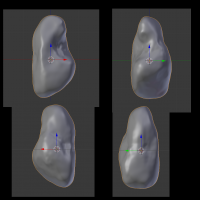Printable Version of Topic
Click here to view this topic in its original format
Unmanned Spaceflight.com _ Cometary and Asteroid Missions _ Giotto’s brief encounter
Posted by: Rakhir Mar 10 2006, 09:20 AM
Giotto’s brief encounter
http://www.esa.int/esaCP/SEMSZ0NVGJE_index_0.html
Twenty years ago, in the night between 13 and 14 March 1986, ESA’s Giotto spacecraft encountered Comet Halley.
Posted by: ljk4-1 Mar 10 2006, 01:06 PM
http://www.esa.int/esaCP/SEMSZ0NVGJE_index_0.html
Twenty years ago, in the night between 13 and 14 March 1986, ESA’s Giotto spacecraft encountered Comet Halley.
I read that Giotto would return to Earth's vicinity in 2016. Would it be possible
to capture the probe to examine what happened to it and get some samples
of Comet Halley embedded in the craft?
Posted by: djellison Mar 10 2006, 01:10 PM
You mentioned the same idea with another spacecraft at some point - but it would be much MUCH easier just to mount a mission to go and collect samples from a comet (i.e. Stardust) than attempt to rendezvous with, encapsulate, and bring home an entire spacecraft. that was never designed to collect samples and is likely to show damage, but certainly not an aerogel like capture of samples.
For all we know, leaking hydrazine might have put Giotto into a massive spin. It might have broken apart, or it might be in a steady state of spin still.
It's a cute idea - bringing these things home - but ultimately pointless and certainly an enormous waste of a very limited budget.
Doug
Posted by: Phil Stooke Mar 10 2006, 02:04 PM
This anniversary is a challenge to the UMSF image processing wizards. Giotto's images are available through the PDS. A great deal more could be done with them using today's techniques... but they are difficult to work with! I did a bit of this a decade ago but didn't take it far. The highest resolution images are tiny postage-stamp views of a small area... I think they could probably be combined to reduce noise and to create new mosaics.
Phil
Posted by: Decepticon Mar 11 2006, 02:23 AM
**^ Waits patiently for someone to work there magic! **
Posted by: Big_Gazza Mar 11 2006, 06:57 AM
Does anyone know if these images from one of the Soviet Vega probes actually show real details on the Halley nucleus, or is this just an example of creating non-existant details via overprocessing ?
Its been 2 decades since Giotto was sand-blasted and ESA released that famous "first-look" at a comet nucleus. I always wondered why other images weren't available, and then I find these on the link posted above. 
Wonder if anyone has a link to any other cunningly-hidden Giotto treasure troves? ![]()
Posted by: Tayfun Öner Mar 11 2006, 09:45 AM
Here is a moasic I made some years ago. I selected the best images but maybe some more can be done by doing what Phil suggests.
http://www.solarviews.com/raw/comet/halley1.gif
Posted by: Bob Shaw Mar 11 2006, 11:15 AM
Hear! Hear!
(drums fingers)
(I can wait all night, you know!)
Bob Shaw
Posted by: BruceMoomaw Mar 11 2006, 11:27 AM
Somebody -- I can't remember who -- told me at the Europa meeting that, even if the Giotto imaging team hadn't decided to indicate different brightnesses with different colors on the live photos, the unprocessed raw photos wouldn't have shown anything comprehensible to human eyes; it took considerable processing to reveal the nucleus on them. So, even if the images had been displayed in the usual way, Margaret Thatcher presumably wouldn't have seen anything on them and would have thrown her purported temper tantrum that led to Britain largely pulling out of the ESA. One really expects more from a chemist.
Posted by: Phil Stooke Mar 11 2006, 11:32 PM
A few replies in one.
Bob, you'll have to wait a while!
Big_Gazza (if that is your real name), the Vega images you showed are heavily over-processed. The apparent fine detail on the nucleus is largely noise. Some of the more subtle and larger features might be real, but the smaller textures are false. Also, you can't trust that the edges of the outlines are the real shape of the limb.
and Tayfun Öner, whose work with maps is always very good - the images I'm interested are the last few images in the sequence, showing a small area near the "small end" of the nucleus. I have a hunch more can be done with them. Don't know when I'll get to it though.
Phil
Posted by: Phil Stooke Mar 20 2006, 06:23 PM
For people who have never seen raw Giotto images before, here are some examples.
Very small images! Not easy to work with. These are all available through the International Halley Watch dataset in PDS, and of course they are provided courtesy of ESA, the Giotto project and camera team leader H. U. Keller.
Phil
Posted by: ljk4-1 Mar 20 2006, 08:21 PM
They almost look like the Deep Impact images just as the impact
was happening, but with a much lighter background.
Thank you for sharing them.
Posted by: BruceMoomaw Mar 20 2006, 11:25 PM
That first set of raw images sure as hell doesn't look "uninterpretable" -- which would seem to show that the ESA really did make a very serious PR mistake by not displaying them live in standard monochrome format. (Of course, they also had no way of knowing that Thatcher would throw a temper tantrum.)
Posted by: rasun Nov 8 2007, 11:36 AM
Does anyone know, if the image data of the 6 spacecraft observing Halley (the "Halley Armada") have been combined together, creating 3D models of the nucleus and the atmosphere, for example?
Second, would it be worth digging up the original Vega images?
Is there anything new we can learn from reprocessing the original images, or there's no relevant development in image processing since '85?
Posted by: djellison Nov 8 2007, 11:46 AM
An increase in image processing technology does not automatically mean new results from old data.
Doug
Posted by: tedstryk Nov 8 2007, 12:38 PM
Second, would it be worth digging up the original Vega images?
Is there anything new we can learn from reprocessing the original images, or there's no relevant development in image processing since '85?
No need to dig...the PDS has them.
Posted by: Phil Stooke Nov 8 2007, 04:15 PM
The Giotto images are very tricky to work with. They are little thumbnail-type images, they are not rectangular. You can't use them for shape modelling without knowing the pointing directions, and you can't know that without knowing the rotation state. It took years to sort that out. A rather dubious shape model is available in PDS. I say dubious because I made it. The fact that nobody has tried to do better than me since then only reinforces how poor the data are. We could really use a close flyby while the nucleus is relatively quiescent, like about now.
My shape is probably too faceted, based on comparisons with Peter Thomas's models of objects I have also done. (His are probably too smooth).
Phil
Posted by: spdf Nov 8 2007, 04:20 PM
Are you sure? The only damaged parts were the camera I thought. And Giotto had another encounter with a comet in 1992 (with Grigg-Skjellerup). In 1999 it had its second Earth fly by. So the damage to the spacecraft might be rather limited? So definite not broken apart.
Posted by: djellison Nov 8 2007, 04:41 PM
It was on a trajectory for that Earth flyby - but the spacecraft was turned off in July 1992. It has not been tracked for more than 15 years. There's no 'definite' about the status of Giotto. We have no idea what sort of state it's in.
Doug
Posted by: Stu Nov 8 2007, 06:05 PM
The Giotto encounter... wow, there was a night... I remember watching it on TV, with Patrick Moore hosting a show on BBC2 which was going to show the images coming in from Giotto live as they were received. My family wanted to watch something on another channel, and we had no VCR at the time, so I was left to keep flicking channels whenever I got the chance until the ITV program finished then I was able to watch the Giotto broadcast.... lots of tense build-up to the appearance of the close approach pictures... The approach pics were good, showing the shape of the nucleus, but we all wanted to see the closest images...
Then they appeared, and showed - well, no-one knew what the hell they showed to be honest! They looked a bit psychedelic to me, a colourful mishmash of no-idea-what... cue lots of puzzled looks from my family as they asked me what they were seeing and I had to admit I really had no idea! ![]()
Posted by: rasun Nov 9 2007, 11:40 AM
Oops, I didn't notice them before; thanks.
Phil: and how did you do the modeling? Was the atmosphere annoying? Did you just forget the parts of the images that clearly a showed gas/dust cloud/jet, and creating the model based on the rest (the quieter parts)? Or how is this sort of job exactly done?
And were the Vega 2 images not detailed enough to be of additional use?
Sorry for too many questions.
Posted by: AndyG Nov 9 2007, 01:56 PM
Was that not the close encounter where James Burke confused the ESA clock times? He wasn't sure whether the "minutes before encounter" time took into account light lag - and therefore the viewers got confused too?
Andy
Posted by: PhilCo126 Sep 7 2008, 01:58 PM
Just read that photos were taken as close as 1300 Km (data taken closer was later recovered) and Giotto passed as close as 606 Km of the nucleus... Just wonder how many photos were taken by Giotto (some sources say 2112 while others list image n° 3475) ![]()
Posted by: Paolo Sep 7 2008, 03:17 PM
In Robotic Exploration vol 2 we have 1703 km and 596 km. we do not have the total number of images but we mention 2043 pictures taken in single CCD mode, which lasted from 20.55 to 23.58 UTC. For the last five minutes of the encounter Giotto used a 4-sensor mode.
Posted by: machi Nov 14 2009, 08:50 PM
I have a question. Can I put here some improved Halley comet images, or do I have to write to dr. H. U. Keller first? There in an information on PDS data set, that the data are copyrighted and the owner of copyright is dr. H. U. Keller. Data are free of charge for scientific purposes. But if I post them here, are they scientific purposes?
Posted by: djellison Nov 14 2009, 09:02 PM
Post them, by all means. It's European data paid for by European tax payers (of which I am one). If anyone moans - they can come and talk to me about it ![]() (and I shall bash them over the head, repeatedly, with my new iPhone 3GS )
(and I shall bash them over the head, repeatedly, with my new iPhone 3GS )
Posted by: Floyd Nov 14 2009, 09:05 PM
Doug or other Admin may give the definitive answer, but I think posting a link to anything on the web is always OK. Then it is up to those who follow the link to download appropriately.
Edit: Doug is too fast
Posted by: ngunn Nov 14 2009, 09:31 PM
I'm keen to see them! Whether what I do with them afterwards is appropriate or not I'll leave to George Orwell. (Nice one Doug - I think you enjoyed posting that. ![]() )
)
Posted by: machi Nov 14 2009, 09:50 PM
Allright. Here is animation from flyby images before camera failure.
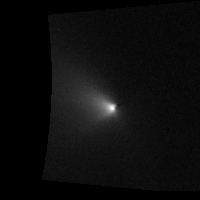
Posted by: Paolo Nov 14 2009, 10:10 PM
Coooool!!
If you could only slow it down a little bit
Posted by: Stu Nov 14 2009, 10:10 PM
GREAT work Machi! Wow, that brought back some memories... ![]()
Posted by: Juramike Nov 14 2009, 10:21 PM
Nice!
Posted by: machi Nov 14 2009, 10:42 PM
If you could only slow it down a little bit
Yes I can, but not on this computer. But I recommend use some movieplayer with adjustable speed. Some like mplayer or so.
Posted by: ugordan Nov 14 2009, 10:43 PM
That's awesome, Machi!
I took your work and stabilized the frames a bit more, do you mind me posting it here?
Posted by: machi Nov 14 2009, 11:02 PM
I took your work and stabilized the frames a bit more, do you mind me posting it here?
Of course you can! Sorry my english isn't so good, so this can be sometimes little problem
Posted by: ugordan Nov 14 2009, 11:12 PM
Ok, http://www.fileden.com/files/2007/9/14/1431389/post-4057-1258234902_stabilized.gif. Just some aligned frames and a slight pause at the end, other than that your work is untouched.
Posted by: nprev Nov 15 2009, 12:16 AM
![]() GREAT work, Machi (& Gordan!) The animation really brings the encounter to life. In fact, the craters on Halley were never obvious to me before; it's a much better presentation of the dataset than offered by the stills.
GREAT work, Machi (& Gordan!) The animation really brings the encounter to life. In fact, the craters on Halley were never obvious to me before; it's a much better presentation of the dataset than offered by the stills.
Posted by: elakdawalla Nov 15 2009, 03:32 AM
Oh, man, that is spectacular. Fabulous work, machi, and nice upgrade, ugordan! If I weren't two sheets to the wind already this evening I'd post it now. Must remember to post it tomorrow or Monday! As a general comment, nearly any time I post an animation I always slow it down substantially (setting frame delays to a minimum of 0.25 seconds) so that the viewer has time for eyes to focus on features in each frame. I also usually put in a pause on the last and first frames in order to allow people the time to recognize that the sequence is starting over.
Posted by: ollopa Nov 15 2009, 04:20 AM
A wonderful reconstruction, but in the interests of absolute historical accuracy I must remind people that these were not the images we saw on the night. I anchored a two-hour TV programme during the encounter and no-one warned us that Giotto was not Voyager. The first and only picture on the night - during hours of live TV coverage across Europe - was this one.
The implications for European space policy were profound. Margaret Thatcher was Prime Minister in the UK and was watching the BBC coverage in the private apartment at Downing Street with, I think, Sir John Fairclough, her science advisor. She asked: "What are we paying for this?". And I'm afraid the rest is history.
Posted by: Stu Nov 15 2009, 07:13 AM
Ah yes, Giotto encounter night, I remember it well, and still get a slightly queasy feeling when I do. I was a youngling then, and as an avid and obsessed-with-space-since-I-was-THIS-high Halley's Comet was a massive, massive deal for me, and I'd been watching it brighten and grow through my 3" scope, from a tiny fuzzball to a slightly bigger fuzzball, and was almost wetting mjyself with excitement on "Giotto Night". I told my family that we absolutely HAD to watch the live TV coverage, and they indulged me and went along with it. So, there we were, all watching the TV, waiting for the images to come in, listening to the "experts" in the studio getting more and more excited as the clock ticked down to closest approach... looking forward to seeing the solid nucleus, the tail, all in close-up... When the actual images came down, and they were just that migraine-inducing splash of colour that looked like someone had spilled paint on the TV screen, and no-one in the studio seemed to know either if the encounter had gone as planned or what the hell they were looking at on the pictures, four sets of eyes turned to me accusingly in a "You made us sit here and wait for this..?" kind of way...
It didn't matter how hard I wished, the ground didn't open up and swallow me.
Of course, I now know that that image was an amazing achiement, and that I'd be very impressed by it if I saw it here on UMSF now, but at the time it was a crushing, crushing disappointment, and I remember thinking how much I preferred the honest view through my own trusty telescope.
I've often wondered how differently things would have turned out if Giotto's images had been more photographic. Would more people here in the UK, and across Europe, have been inspired by space exploration? But, on the other hand, it was covered live on TV, with images shown almost in realtime. That didn't happen with ROSETTA's encounters with Mars or Earth.
Makes you think, doesn't it?
Posted by: Tesheiner Nov 15 2009, 08:07 AM
WOW, just WOW!
Posted by: ngunn Nov 15 2009, 09:05 AM
That is fantastic - ollopa you should have kept the show on air for another 24 years! (I don't remember being disappointed on the night. I remember being delighted that the probe survived the encounter, thrilled and intrigued by the images that no-one could immediately interpret, and proud to be watching a mission run from Europe.)
Posted by: tedstryk Nov 15 2009, 12:50 PM
Excellent work! Which camera is this from?
Posted by: machi Nov 15 2009, 02:01 PM
I think all images are mostly with clear filter (images with index from 1600 to 2017, sensors C and E, camera HMC). These are relatively without noise.
But I lost all original converted images in the spring, so I don't know this surely.
Posted by: djellison Nov 15 2009, 05:48 PM
I would ask a few people who've posted in this thread to re-read the forum rules - specifically -
- 1.2 Politics - the discussion of politics is strictly forbidden. Discussion of politicians, politics, political parties, various topics of the moment (Iraq, Terrorism) are all very much off topic and posts that include them will be removed without warning
Stu - Ollopa - behave.
Note - this is not because what you have said is incorrect. It's because what you have discussed is specifically outside the remit of UMSF.
Posted by: ngunn Nov 16 2009, 11:11 PM
I'm still waiting.
I notice you already have a great Vega 1 animation posted which shows the nucleus looking bright against the background, unlike the Giotto images. I'd be interested to know the geometrical relationship beween the two, the lighting directions etc. Now I've probably complicated the task and will have to wait even longer for your post!
Posted by: ynyralmaen Nov 17 2009, 09:48 AM
I very definitely remember staying up late to watch the BBC coverage, and fortunately I still have a copy of the programme (can't find it posted anywhere on the web though). The BBC did show the live stream of gaudy images as released live by ESA; you can briefly see samples of these at 02:37 on this video:
http://www.youtube.com/watch?v=d9m3lPFUeeA&NR=1
... and the way they disappeared from our screens shortly before closest approach, at 02:57 on this one:
http://www.youtube.com/watch?v=oiRghs0SiR4&feature=related
In the book, "Giotto to the Comets", Nigel Calder states that the blame for the release of the false-colour image stream rather than more easily-decipherable ones rests with a TV producer working with ESA who regarded the greyscale images that the camera team had recommended streaming as being too boring. According to the write-up on the encounter in Astronomy magazine (I guess that would be something like the July 1986 issue), apparently Keller did provide a running commentary and instant, apparently pretty accurate interpretation of the greyscale images to the press as the images came in. The TV and radio correspondents were concentrating on their live coverage however, so it was the reporters from the print media who knew best what was going on! The BBC coverage itself was a bit disjointed because it was a joint Sky at Night and Horizon production: Patrick Moore was in Darmstadt with much better access to information on the encounter's progress, but I recall that most of the coverage came from Greenwich, where James Burke was consulting several high profile experts. The only information on which they could base their comments was however the stream of false-colour images alone, and they understandably had a very hard time explaining what they were looking at. On top of the colour scale, added confusion resulted from the fact that the nucleus itself was dark, not bright. The camera software was written to track the brightest part of the scene, so latched on to the two bright jets at one end of the nucleus as the nucleus filled the field of view.
We must bear in mind that capturing these images was particularly challenging because the camera was mounted on the side of a rapidly-spinning spacecraft (spinning was great for the plasma instruments). The images had to be timed to be captured just as the nucleus swept across the camera's field of view during each spin. The camera itself was pointing "outwards", perpendicular to the spin axis, and actually viewed the nucleus through a rotatable flat mirror. The camera mirror and its baffle had to be rotated to keep in step with the nucleus's motion across the sky as viewed from Giotto, under software control based on tracking the brightest point in the image. It appears that the mirror became pitted due to dust impacts, so the quality decreased towards the end, and the large impact just before closest approach caused the spacecraft to lose balance and to start nutating; sporadic signal losses then occurred. The baffle itself was largely destroyed then or shortly afterwards. Communications were restored thanks to dampers in the spacecraft that brought the nutation back to a tolerable range during the outbound phase.
It was the then-16-year-old Lee Sproats, sitting on the panel in Greenwich, who first guessed correctly that something had gone seriously wrong when the images disappeared, and largely because of that he got to appear on the TV programme for Giotto's second encounter in July 1992.
Posted by: Stefan Nov 17 2009, 01:31 PM
A message from Dr. H.U. Keller:
Hallo machi (and others),
I am really impressed (and not for the first time) what members of the general space community can do with images. The GIF animation impressively shows how small the actual transmitted images (near closest approach) are, only 74 by 74 pixels, and it shows how complex the corrections are for the geometric distortion of the images taken from a rotating spacecraft with a line scanning camera. It also shows that the tracking (autonomous by the computers of the camera) worked very well until Giotto was hit by debris. http://www.mps.mpg.de/homes/schroder/Publications/hmc5.avi is a movie (6MB) for your viewing pleasure simulating the approach, but made from a composite image where 64 images are inserted in an earlier (large image) image providing more and more resolution around the brightest feature. © 1986-2009 MPS.
Finally a word concerning the copyright. The copyright was introduced to control (or prohibit) manipulated images. Publication in a non-profit environment is free and encouraged. So please help to maintain the integrity of the images and the scientific results.
Thanks for your interest. Regards,
H. Uwe Keller
Posted by: ngunn Nov 26 2009, 07:49 PM
Emily has just posted the Giotto Halley movie to her blog, which last September also featured the Vega 1 movie. Here are the two links brought together for convenience:
http://www.planetary.org/blog/article/00001641/
http://www.planetary.org/blog/article/00002230/
Posted by: machi Jan 13 2010, 11:20 AM
Hallo machi (and others),
I am really impressed (and not for the first time) what members of the general space community can do with images. The GIF animation impressively shows how small the actual transmitted images (near closest approach) are, only 74 by 74 pixels, and it shows how complex the corrections are for the geometric distortion of the images taken from a rotating spacecraft with a line scanning camera. It also shows that the tracking (autonomous by the computers of the camera) worked very well until Giotto was hit by debris. http://www.mps.mpg.de/homes/schroder/Publications/hmc5.avi is a movie (6MB) for your viewing pleasure simulating the approach, but made from a composite image where 64 images are inserted in an earlier (large image) image providing more and more resolution around the brightest feature. © 1986-2009 MPS.
Finally a word concerning the copyright. The copyright was introduced to control (or prohibit) manipulated images. Publication in a non-profit environment is free and encouraged. So please help to maintain the integrity of the images and the scientific results.
Thanks for your interest. Regards,
H. Uwe Keller
Thanks for message. Even if images from Giotto aren't so perfect like from Deep Impact, I still think, that this images and whole mission was great achievement. Flyby speed over 60 km/s, low datarate, dangerous environment (evidently more dust than in other cometary flybys, in fact most active comet with imagery) and no one knew like cometary body looks (not easy task for automatic targeting).
I send my second mosaic of comet Halley (first isn't available on net).
All images resampled to 50 m/pix. False color from lower resolution images.
Posted by: ElkGroveDan Jan 13 2010, 02:51 PM
Amazing work Machi. It's like an entirely new mission to give us a better look at Halley.
Posted by: machi Jan 15 2010, 12:51 PM
Thanks Dan!
Third Halley's comet mosaic (and I think my last dayside fullres mosaic for long time). It's full version resampled at 25 m/pix.
Posted by: TrappistPlanets Nov 28 2021, 12:27 PM
i see no one made any maps from the images
so i did
Posted by: JRehling Nov 29 2021, 01:34 AM
Almost all of the details in that "map" are artifacts. It's full of jagged transitions between bright and dark that don't correspond to anything whatsoever in the real world. Nobody's posted anything like that because nobody's interested in artifacts.
Here is a map:
https://solarviews.com/cap/comet/halmap.htm
Posted by: TrappistPlanets Nov 29 2021, 06:24 PM
Here is a map:
https://solarviews.com/cap/comet/halmap.htm
tried to fix the jagged edges
Posted by: scalbers Nov 29 2021, 07:02 PM
Nice to see an attempt to make a new map with a cylindrical projection, if that is useful for such an elongated comet nucleus. How are the coordinates defined? Perhaps with some additional effort it would look more presentable.
Posted by: TrappistPlanets Nov 29 2021, 07:39 PM
the orientation and offset matches the orientation of the model below, so if you texture the model in blender using UV maps, the data should be placed in the correct spots on the model (unless you uv mapped the thing wrong)
and i reprojected the images using the shape model (did a modification to the model to better fit the vega part of the map, model was a bit off)
pics of the fixed mesh
download .STL below
 halley.zip ( 1.22MB )
: 107
halley.zip ( 1.22MB )
: 107Posted by: jasedm Nov 29 2021, 10:16 PM
I think we've been spoilt with the quality of spacecraft images over the last few decades, and whilst it's admirable to attempt a map based on Giotto data from the mid-80's I'm not sure as to the value of such an exercise.
Posted by: Explorer1 Nov 29 2021, 11:04 PM
Yes, I expect for the 2061 perhelion we will have much better capabilities, even for a short flyby. A bit of a wait, of course!
(I do wonder what sort of wild trajectory would one need to actually rendezvous and follow Halley, Rosetta-style?
Posted by: TrappistPlanets Nov 30 2021, 12:14 AM
(I do wonder what sort of wild trajectory would one need to actually rendezvous and follow Halley, Rosetta-style?
so could it still be accepted as a map for comet Halley, until the thing comes back and we preform a good flyby
Posted by: djellison Nov 30 2021, 03:45 PM
A map is only useful if it is instructive. Your map - even with your best effort to fix the jagged edges - is dominated so much by artifacts that any real features are frankly hard to differentiate from the artifacts. I don't think, as a map, it is useful.
Posted by: Paolo Nov 15 2023, 10:23 AM
Just a reminder: next December 9 Halley will be at aphelion.
I wonder whether VLT or another large telescope will again attempt photographong the nucleus.
Powered by Invision Power Board (http://www.invisionboard.com)
© Invision Power Services (http://www.invisionpower.com)

